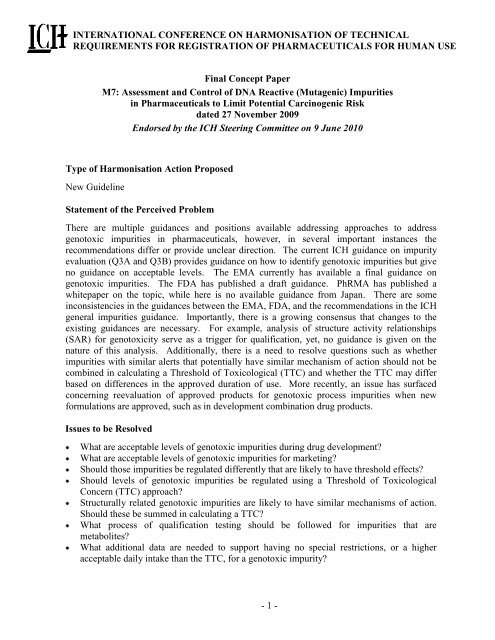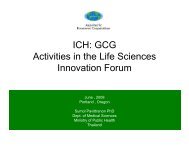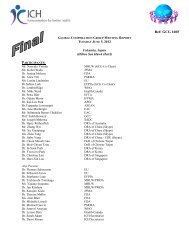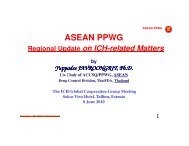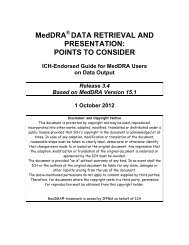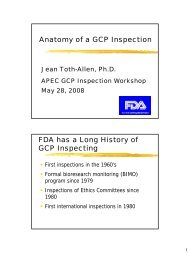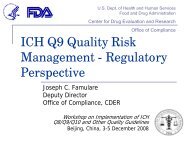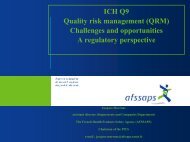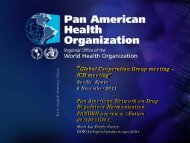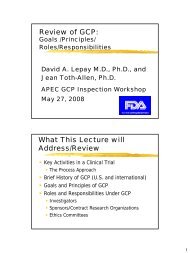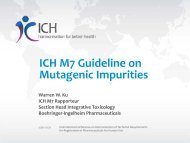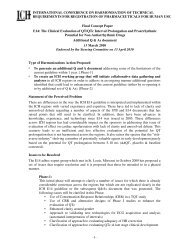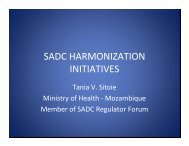Concept Paper - ICH
Concept Paper - ICH
Concept Paper - ICH
You also want an ePaper? Increase the reach of your titles
YUMPU automatically turns print PDFs into web optimized ePapers that Google loves.
INTERNATIONAL CONFERENCE ON HARMONISATION OF TECHNICAL<br />
REQUIREMENTS FOR REGISTRATION OF PHARMACEUTICALS FOR HUMAN USE<br />
Final <strong>Concept</strong> <strong>Paper</strong><br />
M7: Assessment and Control of DNA Reactive (Mutagenic) Impurities<br />
in Pharmaceuticals to Limit Potential Carcinogenic Risk<br />
dated 27 November 2009<br />
Endorsed by the <strong>ICH</strong> Steering Committee on 9 June 2010<br />
Type of Harmonisation Action Proposed<br />
New Guideline<br />
Statement of the Perceived Problem<br />
There are multiple guidances and positions available addressing approaches to address<br />
genotoxic impurities in pharmaceuticals, however, in several important instances the<br />
recommendations differ or provide unclear direction. The current <strong>ICH</strong> guidance on impurity<br />
evaluation (Q3A and Q3B) provides guidance on how to identify genotoxic impurities but give<br />
no guidance on acceptable levels. The EMA currently has available a final guidance on<br />
genotoxic impurities. The FDA has published a draft guidance. PhRMA has published a<br />
whitepaper on the topic, while here is no available guidance from Japan. There are some<br />
inconsistencies in the guidances between the EMA, FDA, and the recommendations in the <strong>ICH</strong><br />
general impurities guidance. Importantly, there is a growing consensus that changes to the<br />
existing guidances are necessary. For example, analysis of structure activity relationships<br />
(SAR) for genotoxicity serve as a trigger for qualification, yet, no guidance is given on the<br />
nature of this analysis. Additionally, there is a need to resolve questions such as whether<br />
impurities with similar alerts that potentially have similar mechanism of action should not be<br />
combined in calculating a Threshold of Toxicological (TTC) and whether the TTC may differ<br />
based on differences in the approved duration of use. More recently, an issue has surfaced<br />
concerning reevaluation of approved products for genotoxic process impurities when new<br />
formulations are approved, such as in development combination drug products.<br />
Issues to be Resolved<br />
What are acceptable levels of genotoxic impurities during drug development?<br />
What are acceptable levels of genotoxic impurities for marketing?<br />
Should those impurities be regulated differently that are likely to have threshold effects?<br />
Should levels of genotoxic impurities be regulated using a Threshold of Toxicological<br />
Concern (TTC) approach?<br />
Structurally related genotoxic impurities are likely to have similar mechanisms of action.<br />
Should these be summed in calculating a TTC?<br />
What process of qualification testing should be followed for impurities that are<br />
metabolites?<br />
What additional data are needed to support having no special restrictions, or a higher<br />
acceptable daily intake than the TTC, for a genotoxic impurity?<br />
- 1 -
FINAL M7 <strong>Concept</strong> <strong>Paper</strong> Endorsed: 9 June 2010<br />
Background to the Proposal<br />
<strong>ICH</strong> Q3A(R) Impurities in New Drug Substances, 2002<br />
<strong>ICH</strong> Q3B(R) Impurities in New Drug Products, 2003<br />
EMA, Guideline on the Limits of Genotoxic Impurities, 2006<br />
EMA, Questions and Answers on the CHMP Guideline on the limits of genotoxic<br />
impurities, 2008<br />
US FDA, Guidance for Industry: Genotoxic and Carcinogenic Impurities in Drug<br />
Substances and Products: Recommended Approaches. Draft, 2008<br />
A rationale for determining, testing and controlling specific impurities in pharmaceuticals<br />
that possess potential for genotoxicity. Regul Toxicol Pharmacol 2006;44:198-211<br />
Type of Expert Working Group<br />
The EWG will be comprised of two members (one chemist and one toxicologist) nominated by<br />
the six sponsors of the <strong>ICH</strong>, and one member nominated by Health Canada, WHO and EFTA<br />
as Observers. IGPA and WSMI will also be invited to nominate one representative.<br />
- 2 -


